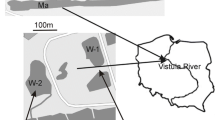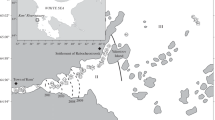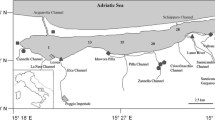Abstract
Observations on phytoplankton in the lower reaches of the rivers Rhine and Meuse were carried out in the framework of the national monitoring programme of the main water systems in The Netherlands. Seasonal changes in density and species composition were analysed to detect the major variables and to discuss whether this monitoring meets its goals. Phytoplankton reached peak densities of 140 and 65 µg L-1 Chl a in the Rhine and Meuse, respectively. Overall density was correlated with seasonal variation in water discharge rather than with nutrient concentrations, that are high in both rivers. The position of sampling sites in relation to the downstream development of the plankton was very important, especially in the regulated Meuse. Despite hydrographic and chemical differences between the two rivers, many species, predominantly diatoms and green algae, were shared. The occurrence of the diatom Skeletonema subsalsum in the Rhine and the green algae Neodesmus danubialis, Micractinium pusillum and Pseudotetrastrum punctatum in the Meuse (1992, but not 1996) was interpreted as a feature related, respectively, to the high salinity of the Rhine and specific riverine conditions of the Meuse. In general the potamoplankton was characterised as an opportunistic assemblage exploiting the high nutrient contents and disturbed hydrography of both rivers. Nevertheless, the phytoplankton contributed to the characterisation of the present river communities, ones that differ rather strongly in historic records. Although year to year variation in phytoplankton density is mainly related to variation in water discharge, phytoplankton biomass did increase as a result of eutrophication over a period of decades. The widespread nature of many of today's potamoplankton species in the two rivers render these organisms less useful for indicating short-term changes in water quality. However the importance of phytoplankton in trophic relationships merits its inclusion in the monitoring of riverine ecosystems.
Similar content being viewed by others
References
Admiraal W, Breebaart L, Tubbing GMJ, van Zanten B, de Ruyter van Steveninck ED, Bijkerk R (1994) Seasonal variation in composition and production of planktonic communities in the lower Rhine. Freshwat. Biol. 32: 519–531.
Admiraal W, Mylius SD, de Ruyter van Steveninck ED, Tubbing DMJ (1993a) A model of phytoplankton in the lower River Rhine verified by observed changes in silicate concentration. J. Plankt. Res. 15: 659–682.
Admiraal W, van der Velde G, Smit H, Cazemier WG (1993) The rivers Rhine and Meuse in The Netherlands: present state and signs of ecological recovery. Hydrobiologia 265: 97–128.
Aldenberg T, Knoop JM, Wortelboer FG, van Puijenbroek PJTM, Kramer PR, van Dijk GM (1997) Het DeltaWat model: Prognose van de waterkwalitieit in de Rijn. H2O 30: 472–477.
Basu BK, Pick FR (1996) Factors regulating phytoplankton and zooplankton biomass in temperate rivers. Limnol. Oceanogr. 41: 1572–1577.
Basu BK, Pick FR (1997) Phytoplankton and zooplankton development in a lowland, temperate river. J. Plankton Res. 19: 237–253.
Bijkerk R, Dijk van GM, van Zanten B (1996) Phytoplankton and zooplankton dynamics in the River Meuse during 1992. Publications and reports of the project 'Ecological rehabilitation of the rivers Rhine and Meuse'. Report 64.
Bijkerk R, Prins KH (1995) Watersysteemrapportage Maas 1992 – Fytoplankton. In Kerkhofs MJJ, Prins KH (eds), Biologische monitoring zoete rijkswateren Maas 1992. RIZA Nota 95.001: 55–61.
Billen G, Garnier J, Hanset Ph (1994) Modelling phytoplankton development in whole lake drainage networks: the RIVER-STRAHLER Model applied to the Seine River System. Hydrobiologia 289: 119–139.
De la Haye MAA (1996) Biologische monitoring zoete Rijkswateren. Operationele uitwerking Fyto-en zoöplankton. RIZA Werkdocument 96.002X.
De Ruyter van Stevenick ED, Admiraal W, Breebaart L, Tubbing GMJ, van Zanten B (1992) Plankton in the River Rhine: structural and functional changes observed during downstream transport. J. Plankton Res. 14: 1351–1368.
De Ruyter van Steveninck ED, van Zanten B, Admiraal W (1990) Phases in the development of riverine plankton: examples from the rivers Rhine and Meuse. Hydrobiol. Bull. 24: 47–55.
Descy JP, Gosselain V (1994) Development and ecological importance of phytoplankton in a large lowland river (River Meuse, Belgium). Hydrobiologia 289: 139–157.
Duel H, Pedroli B, Arts G (1996) Een stroom natuur; natuurstreef-beelden voor Rijn en Maas. RIZA werkdocument 95.173X.
Friedrich G (1990) Das Phytoplankton des Rheins als Indikator. Limnologie Aktuell 1: 181–187. Fischer Verlag, Stuttgart.
Gosselain V, Descy JP, Everbecq E (1994) The phytoplankton community of the River Meuse (Belgium): seasonal dynamics (year 1992) and the possible incidence of zooplankton grazing. Hydrobiologia 289: 171–179.
Hasle GR, Evensen DL (1976) Brackish and freshwater species of the diatom genus Skeletonema II. Skeletonema potamos comb. nov. J. Phycol. 12: 73–82.
Hynes HB (1970) The Ecology of Running Waters, Liverpool University Press. 555 pp.
Ietswaart Th, van Dijk GM (1996) Effecten van eutrofiëring en hydrologische omstandigheden op fytoplankton van de Maas. RIWA rapport 733008002.
Internationale Kommission zum Schutze des Rheins (1987) Aktionsprogramm Rhein.
Internationale Kommission zum Schutze des Rheins (1997) Plankton im Rhein 1995.
Junk WJ, Bayley PB, Sparks RE (1989) The flood-pulse concept in the river floodplain systems. In Dodge DP (ed.), Proceedings of the International Large River Symposium (LARS). Can. Spec. Publ. Fish. aquat. Sci. NO. 106: 110–127.
Köhler J (1994) Origin and succession of phytoplankton in a river-lake system (Spree, Germany). Hydrobiologia 289: 73–85.
Lorenz CM, van Dijk GM, van Hattum AGM, Cofino WP. Concepts in river ecology: implications for indicator development. Regulated Rivers: Research and Management (in press).
McCormick PV, Cairns J, Jr (1997) Algal indicators of aquatic ecosystem condition and change. In Wang W, Gorsuch JW, Hughes JS (eds), Plants for Environmental Studies. Lewis Publishers, Boca Raton, New York: 177–209.
Reynolds CS (1988) Potamoplankton: paradigms, paradoxes and prognoses. In Round FE (ed.), Algae in the aquatic environment. Biopress, Bristol, 285–311.
Reynolds CS (1994) The long, the short and the stalled: on the attributes of phytoplankton selected by physical mixing in lakes and rivers. Hydrobiologia 289: 9–23.
Reynolds CS (1997) Vegetation processes in the pelagic: a model for ecosystem theory. In Kinne O (ed.), Excellence in Ecology 9. Ecology Institute, Oldendorf. 371 pp.
Reynolds CS, Descy JP, Padisàk J (1994) Are phytoplankton dynamics in rivers so different from those in shallow lakes? In Descy JP, Reynolds CS, Padisàk J (eds), Phytoplankton in Turbid Environments: Rivers and Shallow Lakes. Kluwer Acadamic Publishers, Belgium = Hydrobiologia 289: 1–7.
Reynolds CS, Glaister MS (1993) Spatial and temporal changes in phytoplankton abundance in the upper and middle reaches of the River Severn. Arch. Hydrobiol. (Suppl.) 101: 1–22.
Sas H (ed.) (1989) Lake restoration by reduction of nutrient loading. Expectations, experiences, extrapolations. Academia Verlag Richarz Gmbh, Sankt Augustin, Germany. 496 pp.
Sommer U, Gliwicz ZM, Lampert W, Duncan A (1986) The PEG model of a seasonal succession of planktonic events in freshwaters. Arch. Hydrobiol. 106: 433–471.
Ten Brink BJE, Hosper SH, Colijn F (1991) A quantitative method for description and assessment of ecosystems: the AMOEBE approach. Mar. Poll. Bull. 23: 265–270.
Thorp JH, Delong MD (1994) The riverine productivity model: an heuristic view of carbon sources and organic processing in large river ecosystems. Oikos 70: 305–308.
Tilman D, Knops J, Wedin D, Reich P, Ritchie M, Sieman E (1997) The influence of functional diversity and composition on ecosystem processes. Science 277: 1300–1302.
Tubbing GMJ, Admiraal W, Backhaus D, Friedrich G, de Ruyter van Steveninck ED, Müller D, Keller I (1994) Results of an international plankton investigation in the River Rhine. Wat. Sci. Technol. 29: 9–19.
Van den Brink FWB (1994) Impact of hydrology on floodplains lake ecosystems along the lower Rhine and Meuse. Thesis University of Nijmegen, The Netherlands. 196 pp.
Van Dijk GM, van Dam H (1996) Monitoring of algae in running waters in the Netherlands. In Whitton BA, Rott E (eds), Use of Algae for Monitoring Rivers II. Institüt für Botanik, Univ. Innsbruck, 169–170.
Vannote RL, Minshall GW, Cummins KW, Sedell JR, Cushing CE (1980) The River Continuum Concept. Can. J. Fish. aquat. Sci. 37: 130–137.
Wehr JD, Thorpe JH (1997) Effects of navigation dams, tributaries, and littoral zones on phytoplankton in communities in the Ohio River. Can. J. Fish. aquat. Sci. 54: 378–395.
Weijden van MH, Jesse P, Prins KH, Mulder WH (1995) Milieumeetnet zoete Rijkswateren. RIZA Nota 96.005.
Wibaut Isebree Moens NL (1956) Rivierenonderzoek 1954–1955. Rapport in opdracht van Rijkswaterstaat.
Wibaut Isebree Moens NL (1964) Onderzoek van grindgaten langs de Maas. Publ. Natuurhistorisch.
Author information
Authors and Affiliations
Rights and permissions
About this article
Cite this article
Ibelings, B., Admiraal, W., Bijkerk, R. et al. Monitoring of algae in Dutch rivers: does it meet its goals?. Journal of Applied Phycology 10, 171–181 (1998). https://doi.org/10.1023/A:1008049000764
Issue Date:
DOI: https://doi.org/10.1023/A:1008049000764




